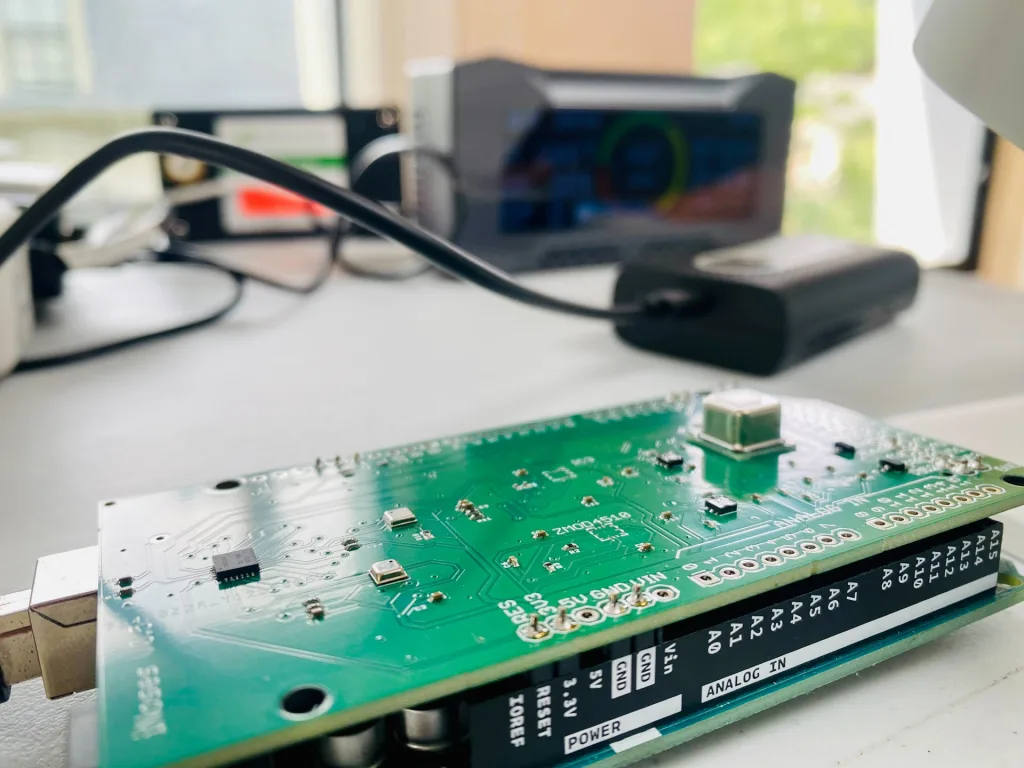- | 8:00 am
Harvard researchers designed an air quality sensor inspired by dogs’ noses
Existing indoor air quality sensors don’t work well. But new tech takes a different approach that mimics how mammals sniff.

The air in your living room might be polluted with formaldehyde from your sofa or fake wood floors, toluene from your wallpaper or shoes, and benzene from your plywood bookcase.
Right now, there’s no simple or cheap way to measure those pollutants. But a new type of sensor from Harvard researchers could help—and it takes inspiration from the way that dogs and other mammals sniff.
The scientists realized that existing air quality sensors didn’t work well at identifying volatile organic compounds or VOCs, chemicals that vaporize into the air from everyday products. “None of the sensors that exist now can tell you specific organic compounds in the air,” says Joanna Aizenberg, a professor at Harvard’s engineering school who focuses on bio-inspired material science.

Some advanced sensors can’t identify VOCs at all. Others can only report “total VOCs”—with no way to differentiate benign chemicals from your morning coffee or the peel of an orange from cancer-causing compounds like benzene. The sensors also aren’t necessarily accurate. Some tests require taking samples that have to be sent to a lab, and can’t give real-time feedback.
To take a different approach, Aizenberg studied olfactory sensors in mammals. Air quality sensors are normally passive, taking a sample of air and then analyzing it. But animals have specific patterns of sniffing depending on what’s in the air—taking several short, fast sniffs, for example, or longer sniffs, and holding the air in their nose for a certain amount of time.
The team’s new sensor system mimics that biological process, combining it with machine learning algorithms. If the system detects a problematic compound in the air, it “sniffs” repeatedly to get more information. That active process makes the sensors much more accurate. In one study using the new approach with existing sensor hardware, the reliability of the results went from 38% to 98%. It’s a cost-effective way to get accurate, real-time air quality data.
The sensor system is “housed in a sleek, compact box, similar to a Nest device,” Aizenberg says, small enough to fit in your hand. Inside, several sensors are mounted on a printed circuit board. (The tentative product name is SNIFFIA, or Sensory Nature-Inspired Fact Finder of Indoor Air.)
Collaborative Fund, a VC fund focused on startups that can help improve the world, is now helping the researchers begin to develop the tech as a consumer product. The project is the first spinout from the Laboratory for Sustainable Materials Research and Innovation, a center that Collaborative Fund helped set up at Harvard’s Wyss Institute.
“The real breakthrough technologies of the last 20 or 30 years were born in the prototypical garage in Silicon Valley,” says Collaborative Fund partner Sophie Bakalar. “That was sort of the incubation space for technology companies. But now, especially within climate, we think that a lot of the breakthrough tech is actually going to originate in university labs.” The firm wanted to help researchers commercialize the best ideas.
Indoor air quality is a somewhat overlooked problem, despite the fact that humans spend around 90% of our time inside. “By the time you’re 40, you breathe 36 years of indoor air,” Bakalar says. Some pollutants are found in higher concentration inside than outside; ventilation systems aren’t always effective. The first product from the startup will focus on five problematic pollutants that are particularly common indoors: formaldehyde, benzene, toluene, ethylbenzene, and xylene. All of them are linked to health impacts. Benzene, for example, is linked to leukemia. Toulene is linked to liver and kidney damage.
The team is continuing to test the sensors’ accuracy and reliability at detecting key chemicals. After the validation process, if all goes as planned, they hope to commercialize a product within two years that could warn consumers about indoor air pollution and make recommendations about how to address the problem.
The tech could eventually be used both in stationary sensors and in other forms, like a wearable that could measure air quality as you move between buildings. By adding new machine learning data, it could identify different pollutants, like mold. Outside, it could be used as a portable sensor when there’s a toxic spill. It’s also feasible that it could be used to detect some diseases—the way that dogs can help diagnose cancer by smell—or to monitor food in the supply chain for spoilage. “The range of applications is quite broad,” says Aizenberg. The team is currently exploring another potential use to track methane emissions on dairy farms. “We’re already thinking about the form factor of our sensor if it would be on the neck of a cow,” she says.






































